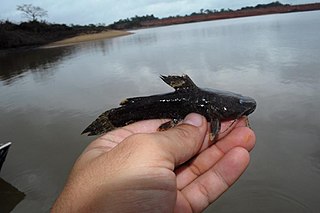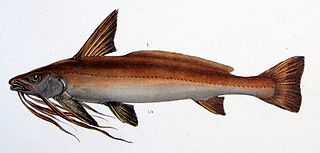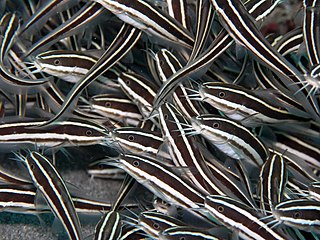Vandellia is a genus of catfishes native to South America. The species in this genus are the most well-known of the parasitic catfishes also known as candiru, known for their alleged habit of entering the human urethra.
Myersglanis is a genus of sisorid catfishes native to Asia.

The gilded catfish or jau is a South American catfish of the family Pimelodidae. It is also known as manguruyu or black manguruyu.

Batrochoglanis is a small genus of catfishes of the family Pseudopimelodidae.

Pinirampus pirinampu is a species of catfish of the family Pimelodidae. P. pirinampu is also known as the flatwhiskered catfish.
Tridensimilis is a genus of pencil catfishes native to South America.
Tridentopsis is a genus of pencil catfishes native to South America.

Gagata is a genus of sisorid catfishes native to Asia.
Pseudostegophilus is a genus of pencil catfishes native to rivers in tropical South America. The members of this genus are obligate parasites that feed on scales and mucus of other fish.
Parastegophilus is a genus of pencil catfishes native to South America.
Schultzichthys is a genus of pencil catfishes native to South America.
Stegophilus is a genus of pencil catfishes native to South America.
Parakysis is a genus of catfishes of the family Akysidae. It includes six species.
The toothless catfish is a species of catfish of the family Plotosidae. This fish originates from northern Australia, including Fitzroy, Daly, East Alligator, Roper, Mitchell, and Archer Rivers, in lentic and lotic freshwater habitats. It grows up to about 40.0 centimetres (15.7 in) TL.
Euristhmus is a genus of eeltail catfishes native to the eastern Indian-western Pacific Oceans around Australia, New Guinea and Indonesia.

Paraplotosus is a genus of catfishes native to Australasia and South-east Asia.

Plotosus is a genus of eeltail catfishes native to the Indian Ocean, the western Pacific Ocean and New Guinea.
Ceratoglanis is a genus of sheatfishes native to Asia.

Belodontichthys is a genus of sheatfishes native to Asia.
Epapterus dispilurus is a species of driftwood catfish distributed in the central and western parts of the Amazon River basin along and south of the main channel of the Amazon River, and Paraguay River basin in Paraguay, northern Argentina and southern Brazil. E. dispilurus grows to 13.0 cm SL. It inhabits the lower part of larger rivers. They are nocturnal, but are also active during dusk and dawn. They feed on smaller fish.






